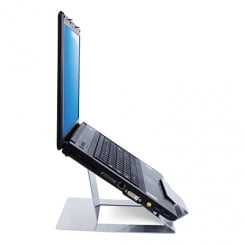Proper office ergonomics is the easiest thing you can do to help keep you comfortable throughout your workday. The more comfortable you are the better you’ll work.
So how do you bring desktop ergonomics into your office?
There are small changes that you can make to your current workstation that will help to reduce pain and bring more comfort. In this blog post, I won’t be covering how your office chair should be set up but if you’d like to find out more about ergonomic office chairs, we have many blog posts covering this topic
How to set up your desk
Is your desk at the correct height? Sit in your chair and tuck yourself under your desk, pay attention to how your body feels, you shouldn’t feel any strain or discomfort.
If your desk is too low:
- Overextended arms when using your mouse and keyboard
- Having to lean forward when working
If your desk is too high:
- If your shoulders are hunched up and feeling tense
- Your elbows are below the desk
- Having to extend your arms forward when using the mouse and keyboard
For more information on desk height watch our YouTube video: How high should your desk be when sitting? What to look for and how to solve it with five simple steps.
How to set up your equipment on your desktop
Having your equipment set up properly on your desk is more important than you think. If you don’t know where to put all your equipment on your desk you can use something called the working zones.
The working zones are ergonomic guidelines for your desk. Small things like having your keyboard too far back on your desk can cause strain on your body and often results in pain and discomfort. The working zones are a simple way to avoid these injuries and they neaten up your desk and help you keep organised.
The working zones are when you split your desk into three different zones, specific equipment should be placed in each zone, for example:
Zone one:
Zone one is the part of the desk that is closest to your body. You should place equipment you the most often here, such as:
- Mouse
- Keyboard
- Notepad/pen
Your mouse should sit right next to your keyboard, so you don’t need to stretch your arm to use your mouse. Using a mouse requires a lot of repetitive motions, if your wrist isn’t in a comfortable position with a natural alignment, it can cause injury and may even develop into carpal tunnel syndrome. To find out more on mouse wrist pain, check out this blog post.
Zone two:
Zone two should be an arm’s length away.
- Headphones/headset
- Drink
- Paperwork
- Telephone
Zone three:
Zone three is the very back of the desk. Things you very rarely use should be put in zone three because It’s the furthest away and you have to stretch to reach it.
- Document folders
- Rarely used stationary
- Picture frame or plant
Our workstation assessor and DSE expert Jo Blood guides through the three working zones and how to use them correctly in this YouTube video:
Where should your monitor/laptop go?
If you’re using a laptop, we would highly recommend that you use a laptop stand with a separate keyboard and mouse. This is because using a laptop without a stand can have a huge negative impact on the user’s posture and health. The reason using a laptop is bad for your posture is because a laptop screen is way too low down, this means the users is having to angle their heads downwards to look at the screen. Over time this causes strain on the neck. Below I’ve pointed out the mistakes in the image and shown what using a laptop stand can look like.

Physiotherapist Nell Mead shared her take on laptops used without a stand/external accessories. I asked her why she isn’t the biggest fan of laptops, Nell said “Mainly because the screen is attached to the keyboard, so either it’s at the right height for your hands, or the right height for your face – or neither. Because unless your spine is unfeasibly short, it can’t be both. If you’re working at the kitchen table, your hands are likely to be too high; or if you’re working at your desk or on the coffee table, you’re likely to have dropped your head down too far. And when your hands and face are too close together for long periods, your spine gets stiff and compressed, and you run the risk of neck pain, back pain, RSI… etc.”
Nell then goes on to say “If you’re going to use a laptop as a desktop replacement, you need to separate the keyboard from the screen. That means getting a stand for your laptop so that the monitor is at the right height (your chin should be about level with the middle of the screen) and buying an external mouse and keyboard so that you’re also able to have your hands at the right height (around an inch lower than your elbows).”
So if you’re using a laptop in replacement of your desktop computer, please use a laptop stand!
-
 Ergo-Q 260 Laptop Stand£131.94 (incl VAT)
Ergo-Q 260 Laptop Stand£131.94 (incl VAT) -
 Addit Laptop Stand£75.24 (incl VAT)
Addit Laptop Stand£75.24 (incl VAT)
Tips for setting up a laptop or a monitor screen:
- The screen should be an arm’s length away, but you should be able to touch the screen still. Stretch out your arms straight in front of you to check if it’s the right distance away.
- Make sure that the top of the screen is level with your eyes or in line with the top of your eyebrows.
Having your screen at the right distance away from you is so important in preventing poor posture and even eye strain. Having an adjustable laptop stand or monitor arm would be useful, but if that’s out of your price range screen risers are a cheap alternative. An even cheaper alternative is a stack of books, just stack some books up under your monitor or laptop until the top of the screen is at eye level.
If you’re having issues with your workstations but can’t pinpoint the issues, a DSE assessment might be useful. A DSE assessment is simple to fill out and only costs 99p, just go through and answer the questions and you’ll know exactly what’s wrong with your current set-up.






